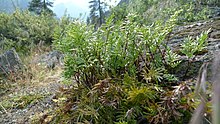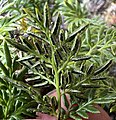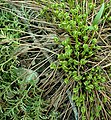| Aspidotis densa | |
|---|---|

| |
| Conservation status | |
 Secure (NatureServe) | |
| Scientific classification | |
| Kingdom: | Plantae |
| Clade: | Tracheophytes |
| Division: | Polypodiophyta |
| Class: | Polypodiopsida |
| Order: | Polypodiales |
| Family: | Pteridaceae |
| Subfamily: | Cheilanthoideae |
| Genus: | Aspidotis |
| Species: | A. densa |
| Binomial name | |
| Aspidotis densa (Brack.) Lellinger, 1968 | |
| Synonyms | |
|
Cheilanthes siliquosa | |
Aspidotis densa is a species of fern in the Cheilanthoid subfamily, known by the common name Indian's dream or Serpentine fern or dense lace fern. It is native to the west coast of North America from British Columbia to California and east to the Rocky Mountains in Idaho, Montana, and Wyoming; there is a disjunct population on serpentine soils in Quebec.
Description
This fern has leaves on long wiry brown to black petioles (stem below the leaf), with the leaf blade occupying less than half of the total length of the leaf when including the petiole. The leaves emerge from a short creeping rhizome covered with firm narrow scales. Where the petiole joins the leaf, the stem color grades to green and acquires a groove on its adaxial (top) surface. The leaf blades are medium to dark green, sometimes with a glaucous or bluish cast. The leaf blade is triangular and composed of many pinnae which are subdivided into narrow leaflets (pinnules). The undersides of leaflets on fertile fronds are covered with sori over which the edges of the leaflet are folded to form a false indusium. Plants often have only fertile fronds, but they sometimes exhibit frond dimorphism, with sterile fronds shorter and with broader and flatter leaflets than the fertile fronds, which rise above on long petioles. The fertile frond leaflets are folded under at the edges and appear narrow and lace-like. The flat leaflets on sterile fronds have a toothed edge, but on fertile fronds these teeth are often reduced and are not easily visible since the edges fold under to form the false indusium. Under some growth conditions only sterile fronds form. Like many ferns, new fronds are produced in spring by circinate vernation.

Habitat
A. densa grows in rocky areas, usually on serpentine soils on rocky mountain slopes, well-drained but seasonally moist. It is usually found in growing full sun, but it can tolerate some shade. It can grow in rock crevices and exposed rocky outcrops in mossy cracks, and over time may creep to fill in fissures, creating well-established colonies in the outcrop. Though it grows mostly on serpentine, A. densa is also found on other rocks and soil types.
Range
A. densa is native largely to the west coast of North America from British Columbia to California and east to the Rocky Mountains in Idaho, Montana, and Wyoming. There is a disjunct population on serpentine soil in Frontenac National Park in Quebec, and closer probably disjunct populations in the Wasatch Mountains of Utah and in the Cuyamaca Mountains near San Diego California, neither apparently associated with serpentine. It typically grows in mountains from low elevations to about 3,000 meters. It also grows near sea level near coasts in a few locations associated with serpentine, notably in Marin County California and in Washington Park and Cypress Island near Anacortes Washington.
As ecologic indicator
Aspidotis densa is a regional ecologic indicator on areas where ultramafic rocks (serpentine) are patchy, such as the Klamath and Siskayou Mountains of northern California and southwest Oregon and the Wenatchee Mountains of Washington. Areas of serpentine soil can typically be seen as areas with sparse plant coverage or open forest bounded by closed forest on the non-ultramafic soils, with Aspidotis densa concentrated in the serpentine areas.
Phylogeny
Relationships between vascular plants with an emphasis on the ferns as summarized from morphological and molecular phylogenetic analyses. Kenrick and Crane (1997) summarizes the results of previously published studies. For a complete fern family phylogeny see Smith et al. (2006).
Gallery
-
 Sterile fronds
Sterile fronds
-
 Sori with false indusium
Sori with false indusium
-
 Iron Peak Wenatchee Mountains
Iron Peak Wenatchee Mountains
-
 Near Ingall's Pass Wenatchee Mountains
Near Ingall's Pass Wenatchee Mountains
-
 Fiddleheads emerging in spring
Fiddleheads emerging in spring
References
- "NatureServe Explorer 2.0".
- ^ Hitchcock, C.L. and Cronquist, A. 2018. Flora of the Pacific Northwest, 2nd Edition, p. 55. University of Washington Press, Seattle.
- Cullina, William. Native Ferns Moss and Grasses. New York, New York: New England Wild Flower Society, 2008.
- ^ "Burke Herbarium Image Collection". biology.burke.washington.edu.
- "Jepson Herbarium". ucjeps.berkeley.edu.
- "Aspidotis densa". iNaturalist. Retrieved 2022-10-14.
- Alexander, Earl B., Roger G. Coleman, Todd Keller-Wolf, and Susan P. Harrison. Serpentine Geoecology of Western North America. Oxford New York: Oxford University Press, 2007.
- Arthur R. Kruckeberg. Geology and Plant Life: The Effects of Landforms and Rock Types on Plants. University of Washington Press, 2002.
- Kenrick, P., and Crane, P. R. (1997). The Origin and Early Diversification of Land Plants: A Cladistic Study. Washington, DC: Smithsonian Institution Press.
- Smith, A. R., Pryer, K. M., Schuettpelz, E., Korall, P., Schneider, H., and Wolf, P. G. (2006). A classification for extant ferns. Taxon 55, 705–731. doi: 10.2307/25065646
External links
- USDA Plants Profile for Aspidotis densa (Indian's dream)
- Calflora Database: Aspidotis densa (Cliffbrake, Indian's dream)
- Jepson Manual eFlora (TJM2) treatment of Aspidotis densa
- Hardy Fern Library
- Flora of North America
- UC Photos gallery — Aspidotis densa
- Aspidotis densa. Encyclopedia of Life.
- Old Jepson Manual Treatment
| Taxon identifiers | |
|---|---|
| Aspidotis densa |
|
| Onychium densum | |